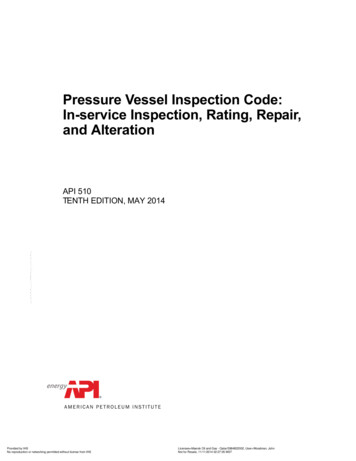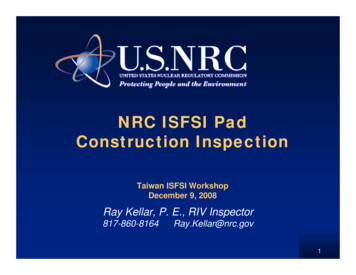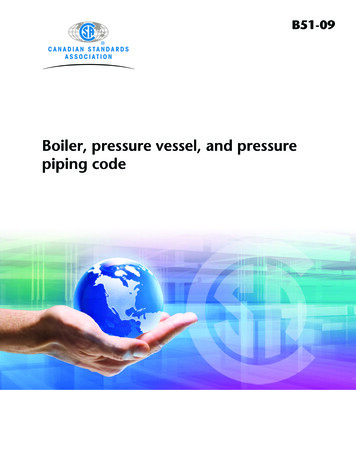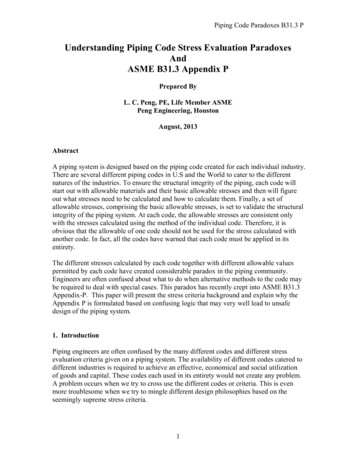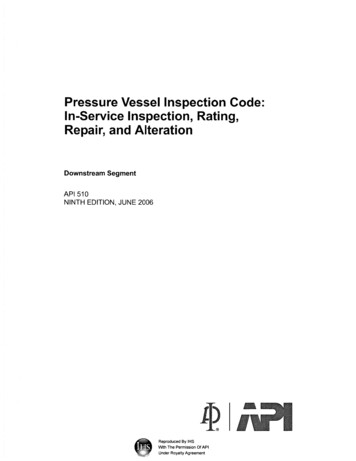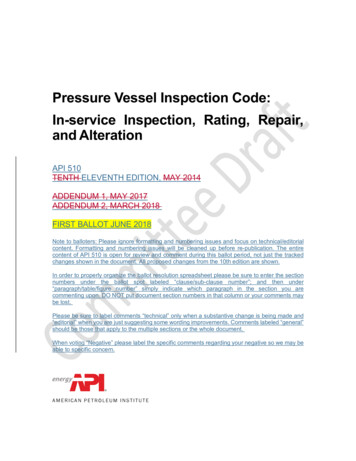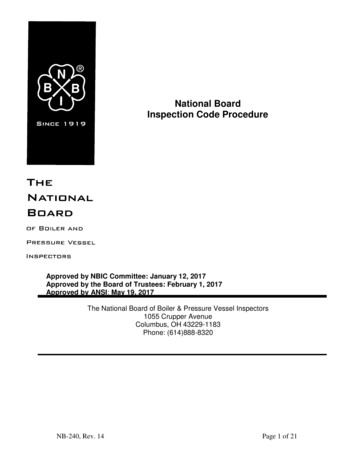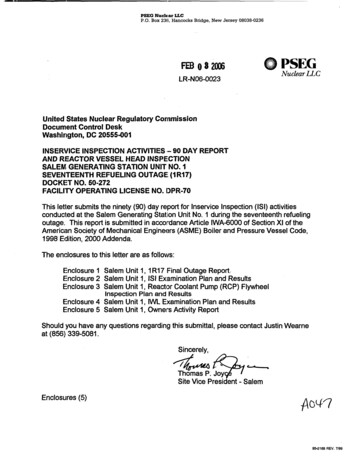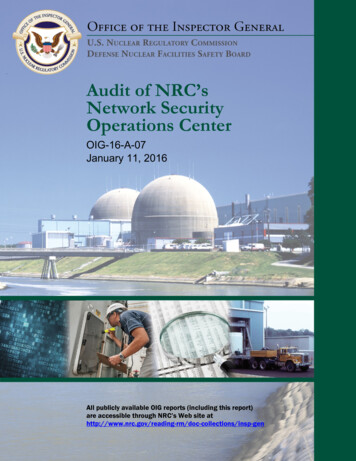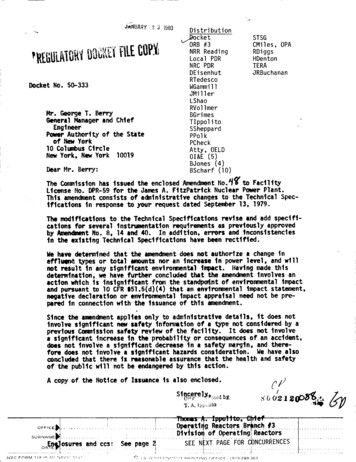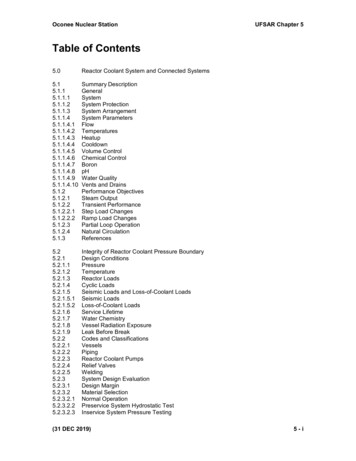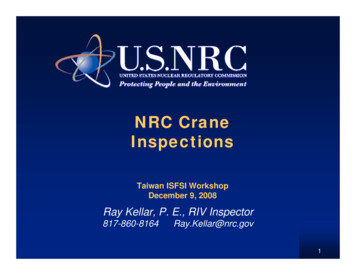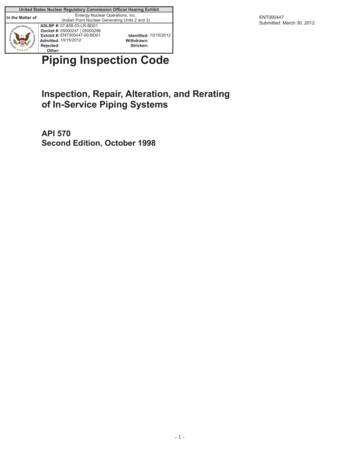
Transcription
United States Nuclear Regulatory Commission Official Hearing ExhibitEntergy Nuclear Operations, Inc.In the Matter of:(Indian Point Nuclear Generating Units 2 and 3)ASLBP #: 07-858-03-LR-BD01Docket #: 05000247 05000286Exhibit #: ENT000447-00-BD01Identified: 10/15/2012Admitted: 447Submitted: March 30, 2012Piping Inspection CodeInspection, Repair, Alteration, and Reratingof In-Service Piping SystemsAPI 570Second Edition, October 1998-1-
Piping Inspection CodeInspection, Repair, Alteration, and Reratingof In-Service Piping SystemsDownstream SegmentAPI 570Second Edition, October 1998-2-
FOREWORDIt is the intent of API to keep this publication up to date. All piping system owners and operators are invited to reporttheir experiences in the inspection and repair of piping systems whenever such experiences may suggest a need forrevising or expanding the practices set forth in API 570.This edition of API 570 supersedes all previous editions of API 570, Piping Inspection Code: Inspection, Repair,Alteration, and Rerating of In-Service Piping Systems. Each edition, revision, or addenda to this API standard may beused beginning with the date of issuance shown on the cover page for that edition, revision, or addenda. Each edition,revision, or addenda, to this API standard becomes effective six months after the date of issuance for equipment that isrerated, reconstructed, relocated, repaired, modified (altered), inspected, and tested per this standard. During thesix-month time between the date of issuance of the edition, revision, or addenda and the effective date, the user shallspecify to which edition, revision, or addenda, the equipment is to be, rerated, reconstructed, relocated, repaired,modified (altered), inspected and tested.API publications may be used by anyone desiring to do so. Every effort has been made by the Institute to assure theaccuracy and reliability of the data contained in them; however, the Institute makes no representation, warranty, orguarantee in connection with this publication and hereby expressly disclaims any liability or responsibility for loss ordamage resulting from its use or for the violation of any federal, state, or municipal regulation with which thispublication may conflict.Suggested revisions are invited and should be submitted to the director of the Downstream Segment, AmericanPetroleum Institute, 1220 L Street, N.W., Washington, D.C. 20005.1 Scope1.1General Application1.1.1CoverageAPI 570 covers inspection, repair, alteration, and rerating procedures for metallic piping systems that have beenin-service.1.1.2IntentAPI 570 was developed for the petroleum refining and chemical process industries but may be used, where practical,for any piping system. It is intended for use by organizations that maintain or have access to an authorized inspectionagency, a repair organization, and technically qualified piping engineers, inspectors, and examiners, all as defined inSection 3.1.1.3LimitationsAPI 570 shall not be used as a substitute for the original construction requirements governing a piping system before itis placed in-service; nor shall it be used in conflict with any prevailing regulatory requirements.1.2Specific Applications1.2.1Included Fluid ServicesExcept as provided in 1.2.2, API 570 applies to piping systems for process fluids, hydrocarbons, and similar flammableor toxic fluid services, such as the following:a.b.c.d.Raw, intermediate, and finished petroleum products.Raw, intermediate, and finished chemical products.Catalyst lines.Hydrogen, natural gas, fuel gas, and flare systems.-3-
e.f.Sour water and hazardous waste streams above threshold limits, as defined by jurisdictional regulations.Hazardous chemicals above threshold limits, as defined by jurisdictional regulations.1.2.2Excluded and Optional Piping SystemsThe fluid services and classes of piping systems listed below are excluded from the specific requirements of API 570but may be included at the owner’s or user’s (owner/user’s) option.a.Fluid services that are excluded or optional include the following:1. Hazardous fluid services below threshold limits, as defined by jurisdictional regulations.2. Water (including fire protection systems), steam, steam-condensate, boiler feed water, and Category D fluidservices, as defined in ASME B31.3.b.Classes of piping systems that are excluded or optional are as follows:1. Piping systems on movable structures covered by jurisdictional regulations, including piping systems ontrucks, ships, barges, and other mobile equipment.2. Piping systems that are an integral part or component of rotating or reciprocating mechanical devices, such aspumps, compressors, turbines, generators, engines, and hydraulic or pneumatic cylinders where the primarydesign considerations and/or stresses are derived from the functional requirements of the device.3. Internal piping or tubing of fired heaters and boilers, including tubes, tube headers, return bends, externalcrossovers, and manifolds.4. Pressure vessels, heaters, furnaces, heat exchangers, and other fluid handling or processing equipment,including internal piping and connections for external piping.5. Plumbing, sanitary sewers, process waste sewers, and storm sewers.6. Piping or tubing with an outside diameter not exceeding that of NPS ½.7. Nonmetallic piping and polymeric or glass-lined piping.2 ReferencesThe most recent editions of the following standards, codes, and specifications are cited in this code.API510Pressure Vessel Inspection CodePubl 920 Prevention of Brittle Fracture of Pressure VesselsPubl 2201 Procedures for Welding or Hot Tapping on Equipment Containing FlammablesRP 574Inspection of Piping System ComponentsRP 651Cathodic Protection of Aboveground Petroleum Storage TanksRP 750Management of Process HazardsStd 598Valve Inspection and TestingGuide for Inspection of Refinery Equipment, Chapter II (This document will be replaced by API RP 571, ConditionsCausing Deterioration or Failures, currently under development.)API 570 Inspector Certification Exam Body of KnowledgeASMEB16.34Valves-Flanged, Threaded, and Welding EndB31.3Process PipingB31GManual for Determining the Remaining Strength of Corroded PipelinesBoiler and Pressure Vessel Code, Section VIII, Divisions 1 and 2; Section IX,ASNTSNT-TC-1ACP-189Standard for Qualification and Certification of Nondestructive Testing Personnel-4-
ASTMG57NACERP0169RP0170Method for Field Measurement of Soil Resistivity Using the Wenner Four-Electrode MethodRP0274RP0275Control of External Corrosion on Underground or Submerged Metallic Piping SystemsProtection of Austenitic Stainless Steels from Polythionic Acid Stress Corrosion Cracking DuringShutdown of Refinery EquipmentHigh-Voltage Electrical Inspection of Pipeline Coatings Prior to InstallationApplication of Organic Coatings to the External Surface of Steel Pipe for Underground ServiceNFPA704Identification of the Fire Hazards of Materials3DefinitionsFor the purposes of this standard, the following definitions apply.3.1alteration: A physical change in any component that has design implications affecting the pressure containingcapability or flexibility of a piping system beyond the scope of its design. The following are not consideredalterations: comparable or duplicate replacement; the addition of any reinforced branch connection equal to orless than the size of existing reinforced branch connections; and the addition of branch connections not requiringreinforcement.3.2applicable code: The code, code section, or other recognized and generally accepted engineering standard orpractice to which the piping system was built or which is deemed by the owner or user or the piping engineer tobe most appropriate for the situation, including but not limited to the latest edition of ASME B31.3.3.3ASME B31.3: A shortened form of ASME B31.3, Process Piping, published by the American Society ofMechanical Engineers. ASME B31.3 is written for design and construction of piping systems. However, most ofthe technical requirements on design, welding, examination, and materials also can be applied in the inspection,rerating, repair, and alteration of operating piping systems. When ASME B31.3 cannot be followed because ofits new construction coverage (such as revised or new material specifications, inspection requirements, certainheat treatments, and pressure tests), the piping engineer or inspector shall be guided by API 570 in lieu of strictconformity to ASME B31.3. As an example of intent, the phrase “principles of ASME B31.3” has beenemployed in API 570, rather than “in accordance with ASME B31.3.”3.4authorized inspection agency: Defined as any of the following:3.5a.The inspection organization of the jurisdiction in which the piping system is used.b.The inspection organization of an insurance company that is licensed or registered to write insurance forpiping systems.c.An owner or user of piping systems who maintains an inspection organization for activities relating only tohis equipment and not for piping systems intended for sale or resale.d.An independent inspection organization employed by or under contract to the owner or user of pipingsystems that are used only by the owner or user and not for sale or resale.e.An independent inspection organization licensed or recognized by the jurisdiction in which the pipingsystem is used and employed by or under contract to the owner or user.authorized piping inspector: An employee of an authorized inspection agency who is qualified and certified toperform the functions specified in API 570. A nondestructive (NDE) examiner is not required to be anauthorized piping inspector. Whenever the term inspector is used in API 570, it refers to an authorized pipinginspector.-5-
3.6auxiliary piping: Instrument and machinery piping, typically small-bore secondary process piping that can beisolated from primary piping systems. Examples include flush lines, seal oil lines, analyzer lines, balance lines,buffer gas lines, drains, and vents.3.7critical check valves: Valves that have been identified as vital to process safety and must operate reliably inorder to avoid the potential for hazardous events or substantial consequences should a leak occur.3.8CUI: Corrosion under insulation, including stress corrosion cracking under insulation.3.9deadlegs: Components of a piping system that normally have no significant flow. Examples include thefollowing: blanked branches, lines with normally closed block valves, lines with one end blanked, pressurizeddummy support legs, stagnant control valve bypass piping, spare pump piping, level bridles, relief valve inletand outlet header piping, pump trim bypass lines, high-point vents, sample points, drains, bleeders, andinstrument connections.3.10 defect: An imperfection of a type or magnitude exceeding the acceptable criteria.3.11 design temperature of a piping system component: The temperature at which, under the coincident pressure, thegreatest thickness or highest component rating is required. It is the same as the design temperature defined inASME B31.3 and other code sections and is subject to the same rules relating to allowances for variations ofpressure or temperature or both. Different components in the same piping system or circuit may have differentdesign temperatures. In establishing the design temperature, consideration shall be given to process fluidtemperatures, ambient temperatures, heating and cooling media temperatures, and insulation.3.12 examiner: A person who assists the inspector by performing specific nondestructive examination (NDE) onpiping system components but does not evaluate the results of those examinations in accordance with API 570,unless specifically trained and authorized to do so by the owner or user. The examiner need not be qualified inaccordance with API 570 or be an employee of the owner or user but shall be trained and qualified in theapplicable procedures in which the examiner is involved. In some cases, the examiner may be required to holdother certifications as necessary to satisfy owner or user requirements. Examples of other certification that maybe required are SNT-TC-1A or CP-189; or AWS Welding Inspector certification. The examiner’s employershall maintain certification records of the examiners employed, including dates and results of personnelqualifications, and shall make them available to the inspector.3.13 hold point: A point in the repair or alteration process beyond which work may not proceed until the requiredinspection has been performed and documented.3.14 imperfections: Flaws or other discontinuities noted during inspection that may be subject to acceptance criteriaduring an engineering and inspection analysis.3.15 indication: A response or evidence resulting from the application of a nondestructive evaluation technique.3.16 injection point: Locations where relatively small quantities of materials are injected into process streams tocontrol chemistry or other process variables. Injection points do not include locations where two process streamsjoin (mixing tees). Examples of injection points include chlorine in reformers, water injection in overheadsystems, polysulfide injection in catalytic cracking wet gas, antifoam injections, inhibitors, and neutralizers.3.17 in-service: Refers to piping systems that have been placed in operation, as opposed to new construction prior tobeing placed in service.3.18 inspector: An authorized piping inspector.3.19 jurisdiction: A legally constituted government administration that may adopt rules relating to piping systems.3.20 level bridle: A level gauge glass piping assembly attached to a vessel.3.21 maximum allowable working pressure: (MAWP): The maximum internal pressure permitted in the pipingsystem for continued operation at the most severe condition of coincident internal or external pressure andtemperature (minimum or maximum) expected during service. It is th
Each edition, revision, or addenda to this API standard may be used beginning with the date of issuance shown on the cover page for that edition, revision, or addenda. Each edition, revision, or addenda, to this API standard becomes effective six months after the date of issuance for equipment that is rerated, reconstructed, relocated, repaired, modified (altered), inspected, and tested per .
